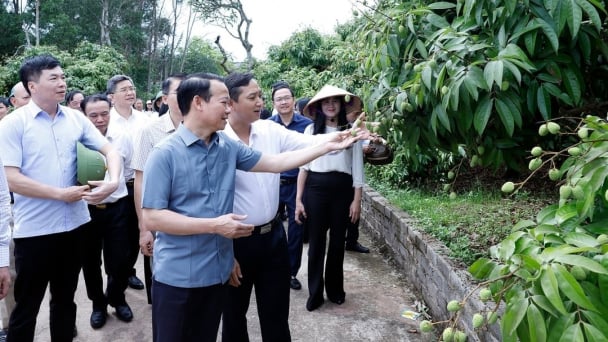May 14, 2025 | 23:04 GMT +7
May 14, 2025 | 23:04 GMT +7
Hotline: 0913.378.918
May 14, 2025 | 23:04 GMT +7
Hotline: 0913.378.918

The United States market is one of the most demanding in the world, particularly for citrus.
For the US market, Vietnamese fruit products in general and tropical fruits in particular remain serving for Vietnamese, Chinese, and Asians in the the US and struggles to access indigenous consumers.
Recent exports of Vietnamese mangoes, grapefruits, and durians to the United States have enabled us to establish a foothold in this challenging market. Perhaps the quantity is modest and insufficient for Vietnamese businesses to negotiate with significant partners in the United States, but it has contributed tremendously to promoting the image and quality of Vietnamese fruits and agricultural products in the United States.
It is also a significant landmark, given that the United States market is one of the most demanding in the world, particularly for citrus. It takes Thais several years to capitalize on this market, whereas Vietnamese can do so immediately. Success is the consequence of an advancement in market research, recognizing the competitive advantage of products in order to develop a competitive strategy.
First, in terms of product quality, Americans have a high regard for Vietnamese fruits. I recall that in 2016, when US Department of Agriculture representatives arrived to work with Chanh Thu, we introduced them to Ben Tre's native grapefruit, which everyone extolled. Mango, durian, and a few other Vietnamese fruit products have made a significant impact on the U.S. market. In general, the Vietnamese refrigerated durian product Ri6, which was recently introduced to the US market, is currently very well received. Numerous large partners place orders, but we are unable to fulfill them, particularly for very large retail chains like Walmart, Costco Wholesale, etc.
Previously for the US market, when durian was mentioned, they thought of Thailand, but now we have positioned the product as "made in Vietnam," which is extremely important, demonstrating that the potential, opportunity for Vietnamese fruits in the US market is enormous, we must develop a strategy, recognize the advantages and disadvantages, and ensure product quality.
I was lucky enough to travel to the United States with Prime Minister Pham Minh Chinh and Minister of Agriculture and Rural Development Le Minh Hoan last year. Participating in meetings with Walmart Group to establish a connection between Vietnamese agriculture and this global hypermarket chain. This trip, along with previous ones, enhanced our knowledge and experience. Experiences and lessons about the US market from which to devise a development strategy and improve the production and processing chain in order to penetrate this market further with Vietnamese citrus products. The efforts of the Government, Ministry of Agriculture and Rural Development, and state management agencies are also creating new export opportunities for agricultural cooperation between Vietnam and the United States. Vietnamese agricultural products, including citrus products, are infiltrating the US market in increasing numbers.
In actuality, we can divide Vietnamese fruits into two primary categories: fresh fruit products and frozen fruit products. Regarding fresh fruit products, following grapefruit and mango, I believe we must develop a strategy to increase the number of product lines in order to reach and expand the market in the United States, particularly for Vietnam's advantageous product lines, which currently number between 8 and 9. We must determine our primary objective for reaching and capturing local consumers.
For deep-processed, convenient, and long-lasting products, global or American consumers have increased demands for freeze-dried fruits, per market trends. This presents an opportunity, among others, for frozen fruit, dehydrated fruit, and fruit-flavored chocolates. This necessitates the diversification of our product categories and the transformation of traditional Asian products into those more suited to American preferences. Enhance the role of Vietnamese agencies and communities in the United States, improve communication, and collaborate with the business community to promote the image and quality of Vietnamese produce.
For the business community, cooperatives, and farmers, I hope that all stakeholders, particularly enterprises exporting agricultural products to the U.S. market, can sit down together to plan clear and methodical strategies, constructing a chain of sustainable links for common objectives. Because with the US market, we need to recognize that we have a not-too-large market share and not too many businesses, so we must work together to build a strategy to exploit the market and diversify products to create convenient products, meeting the needs and tastes of consumers in the US market, creating a competitive advantage compared to other countries.
We must promptly strengthen the current linkage. I am always looking to collaborate with other enterprises on this endeavor. As soon as we enter the retail channels of the world's largest corporations, our market will no longer be limited to the United States but will be global. Global corporations with systems in multiple countries will constitute an enormous market, and Chanh Thu cannot compete alone.
We must work collaboratively to establish trust and national product brands. Let's go together so that when working with multinational corporations on the international market, the tale of Vietnamese agricultural products will not be limited to Chanh Thu, Dong Giao, and Nafoods. It will be a large enough corporation to represent Vietnam, diversify its product line, and confidently introduce Vietnamese agricultural products to international supply chain systems.
Lastly, regardless of whether the market is in the United States, China, or another country, we must recognize that all are challenging in terms of completing the product chain and developing the highest quality goods. This is the basis for State management agencies and enterprises to actively search out and expand their markets. If we depend on a particular market over the long term, there is a chance that it will be challenging to regulate product output and the industry.
Translated by Linh Linh

(VAN) The launch of the Vietnam green and low-emission rice brand is a positive signal for both businesses and farmers, marking readiness to reach new heights in the global market.

(VAN) The U.S. tariff will have a significant impact on Vietnam’s wood industry as well as the U.S. furniture market. A reasonable tariff rate would be beneficial for both sides.

(VAN) India's retail inflation remained below the central bank's 4% target for the third consecutive month as food prices rose at a slower pace, opening up room for more interest rate cuts.
![Multi-channel, multi-directional Vietnamese agricultural markets: [5] Safety is the key](https://t.ex-cdn.com/nongnghiepmoitruong.vn/608w/files/linhnhp/2025/05/13/trai-cay-viet-nam-170345_133-221148-0908330.jpg)
(VAN) The Middle Eastern market presents new opportunities for Vietnamese agricultural products, but safety in product quality, payment, and partnership relations is a fundamental principle.

(VAN) Vietnam's participation in the AGROALBA project helps open up broader investment opportunities for enterprises to access markets in the fields of agriculture.

(VAN) On May 13, Deputy Minister of Agriculture and Environment Phung Duc Tien held a meeting with Cuban Deputy Minister of the Food Industry Javier Francisco Agular Rodriguez.

(VAN) Agriculture and environment sector experienced a 3.74% increase in growth during the first four months of 2025, with exports surpassing 21 billion USD. This growth was sustained by effective reforms and a trade surplus.